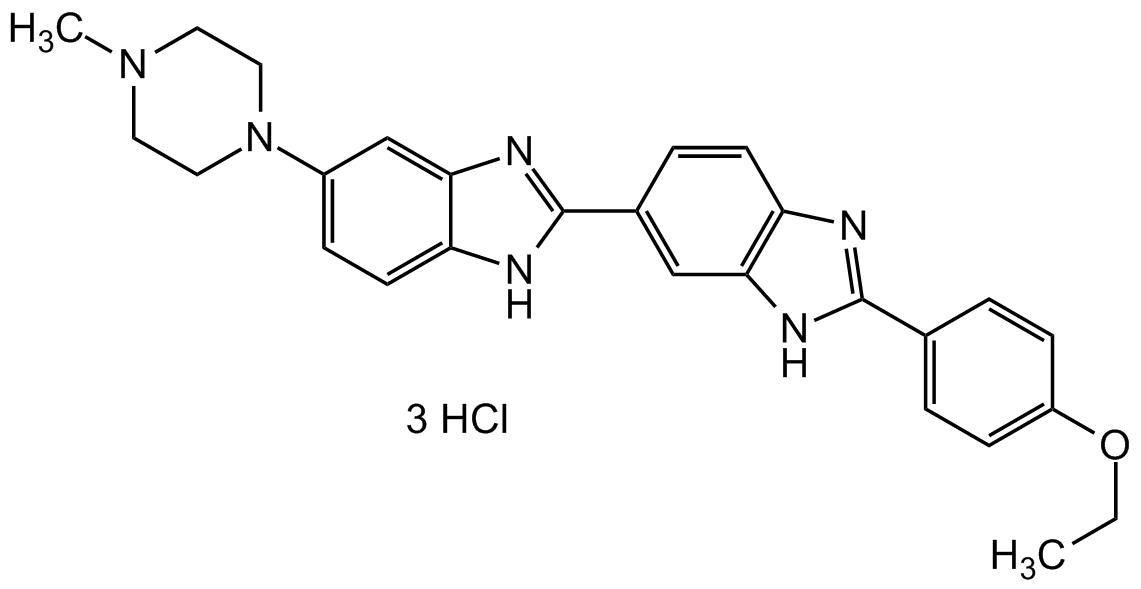Hoechst 33342 Solution
| Code | Size | Price |
|---|
| CDX-B0447-L005 | 5 ml | £132.00 |
Quantity:
Prices exclude any Taxes / VAT
Overview
Regulatory Status: RUO
Shipping:
AMBIENT
Storage:
+4°C
Images
Documents
Further Information
Alternate Names/Synonyms:
2'-(4-Ethoxyphenyl)-5-(4-methyl-1-piperazinyl)-2,5'-bi-1H-benzimidazole trihydrochloride; BisBenzimide H 33342; HOE 33342
Appearance:
Liquid.
CAS:
23491-52-3
Concentration:
1mg/ml in water
EClass:
32160000
Form (Short):
liquid
GHS Symbol:
GHS07,GHS08
Handling Advice:
Protect from light and moisture.
Hazards:
H302-H315-H335-H341
InChi:
InChI=1S/C27H28N6O/c1-3-34-21-8-4-18(5-9-21)26-28-22-10-6-19(16-24(22)30-26)27-29-23-11-7-20(17-25(23)31-27)33-14-12-32(2)13-15-33/h4-11,16-17H,3,12-15H2,1-2H3,(H,28,30)(H,29,31)
InChiKey:
PRDFBSVERLRRMY-UHFFFAOYSA-N
Long Description:
Chemical. CAS: 23491-52-3. Formula: C27H28N6O . 3HCl . xH2O. MW: 561.93. The Hoechst stains are a family of fluorescent stains for labeling DNA in fluorescence microscopy. The blue fluorescent Hoechst dye is a cell permeable nucleic acid stain that has multiple applications, including sensitive detection of DNA in the presence of RNA in agarose gels, automated DNA determination, sensitive determination of cell number and chromosome sorting. Useful vital stain for the flow cytometric recognition of DNA damage and other viability measurements by monitoring the emission spectral shifts of the dyes. Because this fluorescent stain labels DNA, it can also be used to visualize nuclei and mitochondria. Hoechst 33342 is a cell-permeable, benzimidazole dye that stains DNA by binding to the minor groove of adenine and thymine-rich sequences. It emits blue fluorescence (excitation 350 nm/emission maximum 461 nm) when bound to double stranded DNA and is useful as a marker of nuclei for cell cycle studies and to distinguish nuclear morphology in apoptotic cells.
MDL:
MFCD00012678
Molecular Formula:
C27H28N6O . 3HCl . xH2O
Molecular Weight:
561.93
Package Type:
Vial
Precautions:
P280-P301 + P312 + P330
Product Description:
The Hoechst stains are a family of fluorescent stains for labeling DNA in fluorescence microscopy. The blue fluorescent Hoechst dye is a cell permeable nucleic acid stain that has multiple applications, including sensitive detection of DNA in the presence of RNA in agarose gels, automated DNA determination, sensitive determination of cell number and chromosome sorting. Useful vital stain for the flow cytometric recognition of DNA damage and other viability measurements by monitoring the emission spectral shifts of the dyes. Because this fluorescent stain labels DNA, it can also be used to visualize nuclei and mitochondria. Hoechst 33342 is a cell-permeable, benzimidazole dye that stains DNA by binding to the minor groove of adenine and thymine-rich sequences. It emits blue fluorescence (excitation 350 nm/emission maximum 461 nm) when bound to double stranded DNA and is useful as a marker of nuclei for cell cycle studies and to distinguish nuclear morphology in apoptotic cells.
Purity:
>98% (HPLC)
Signal Word:
Warning
SMILES:
CN(CC1)CCN1C2=CC=C(NC(C3=CC(NC(C4=CC=C(OCC)C=C4)=N5)=C5C=C3)=N6)C6=C2
Solubility Chemicals:
Soluble in water.
Source / Host:
Synthetic
Transportation:
Non-hazardous
UNSPSC Category:
Fluorescent Reagents
UNSPSC Number:
41105331
Use & Stability:
Stable for at least 2 years after receipt when stored at +4°C.
References
(1) D.J. Pierce et al.: Exp. Hematol. 35(9), 1437 (2007) | (2) M.E. Lalande et al.: Proc. Natl. Acad. Sci. USA 78, 363 (1981) | (3) M.J. Lydon et al.: J. Cell. Physiol. 102, 175 (1980)



